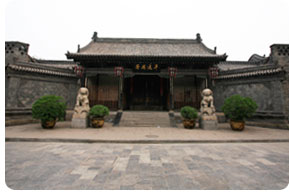 The ancient city is in Pingyao County, Shanxi Province. The city wall was first built during the Zhou Dynasty (11th century - 256 B.C.) and was expanded in 1370, the third year of the reign of Ming Emperor Hongwu. Since 1997, it has been listed as a World Heritage Site. Now Pingyao city is the only one in China completely reserved as it was hundreds of years ago, no modern buildings, only narrow stone-plate street with many Chinese-style shops on the two sides.
The ancient city is in Pingyao County, Shanxi Province. The city wall was first built during the Zhou Dynasty (11th century - 256 B.C.) and was expanded in 1370, the third year of the reign of Ming Emperor Hongwu. Since 1997, it has been listed as a World Heritage Site. Now Pingyao city is the only one in China completely reserved as it was hundreds of years ago, no modern buildings, only narrow stone-plate street with many Chinese-style shops on the two sides.
The perimeter of this square city is 6.4km long and the city wall is the earliest and largest intact city wall in China. It is 12m high with an average width of 5m. The wall is rammed earth strengthened with a covering of bricks. Outside the city wall there is a moat, 4m wide and 4m deep.
The city has six gates, two each on the east and west and one each in the south and north side. All the gates project outwards and have two doors each. This has given the city the name "Turtle City" with the two gates on the south and north representing the head and tail of the turtle and four gates on the east and west as the four legs. The doors on the south and north stand opposite each other, like the head of the turtle extending out and two wells just beyond southern gate are like a turtle's two eyes.
Located on the trade route between Beijing and Xi'an, Pingyao developed into a merchant center where enterprising locals set up the nation's earliest banks. These institutions were the first in China to use checks, and business peaked in the 19th Century, when the city was the undisputed financial center of the Qing government.
Several old courtyards have been turned into museums, most notably the homes and offices of Pingyao's old tongs, or banks. One of the most remarkable aspects of a visit here is realizing that this remote place was immensely important to China's financial history.
Rishengchang and the Baichuan Tong, two of the most powerful banks in the old days, are now small museums that have been restored tastefully. The same can be said of the Yuanmiancheng Minfeng Hotel, where modern beds are replaced with old kang, or traditional coal-heated brick bed. The hotel's gray-brick courtyards and rooms haven't been over-restored (and there is the additional if slightly strange convenience of having an upstairs museum dedicated to an exhibit of drawings and photos that document the history of "three-inch golden lilies," or bound feet). The hotel, constructed about 500 years ago, actually is same old as others in the city, and thus is not so distinguished on the old street.
Most of Pingyao local people originated from a business family, because Shanxi and thus Pingyao has a long tradition and history in business. Shanxi Business People (Jin Shang) were quite famous in Ming and Qing dynasties. |



